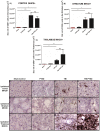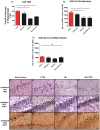Influence of post-traumatic stress disorder on neuroinflammation and cell proliferation in a rat model of traumatic brain injury
- PMID: 24349091
- PMCID: PMC3857205
- DOI: 10.1371/journal.pone.0081585
Influence of post-traumatic stress disorder on neuroinflammation and cell proliferation in a rat model of traumatic brain injury
Abstract
Long-term consequences of traumatic brain injury (TBI) are closely associated with the development of severe psychiatric disorders, such as post-traumatic stress disorder (PTSD), yet preclinical studies on pathological changes after combined TBI with PTSD are lacking. In the present in vivo study, we assessed chronic neuroinflammation, neuronal cell loss, cell proliferation and neuronal differentiation in specific brain regions of adult Sprague-Dawley male rats following controlled cortical impact model of moderate TBI with or without exposure to PTSD. Eight weeks post-TBI, stereology-based histological analyses revealed no significant differences between sham and PTSD alone treatment across all brain regions examined, whereas significant exacerbation of OX6-positive activated microglial cells in the striatum, thalamus, and cerebral peduncle, but not cerebellum, in animals that received TBI alone and combined TBI-PTSD compared with PTSD alone and sham treatment. Additional immunohistochemical results revealed a significant loss of CA3 pyramidal neurons in the hippocampus of TBI alone and TBI-PTSD compared to PTSD alone and sham treatment. Further examination of neurogenic niches revealed a significant downregulation of Ki67-positive proliferating cells, but not DCX-positive neuronally migrating cells in the neurogenic subgranular zone and subventricular zone for both TBI alone and TBI-PTSD compared to PTSD alone and sham treatment. Comparisons of levels of neuroinflammation and neurogenesis between TBI alone and TBI+PTSD revealed that PTSD did not exacerbate the neuropathological hallmarks of TBI. These results indicate a progressive deterioration of the TBI brain, which, under the conditions of the present approach, was not intensified by PTSD, at least within our time window and within the examined areas of the brain. Although the PTSD manipulation employed here did not exacerbate the pathological effects of TBI, the observed long-term inflammation and suppressed cell proliferation may evolve into more severe neurodegenerative diseases and psychiatric disorders currently being recognized in traumatized TBI patients.
Conflict of interest statement
Figures





References
-
- Faul M, Xu L, Wald MM, Coronado VG (2010) Traumatic brain injury in the United States: Emergency department visits, hospitalizations and deaths. Atlanta (GA): Centers for Disease Control and Prevention, National Center for Injury Prevention and Control.
-
- Sosin DM, Sniezek JE, Waxweiler RJ (1995) Trends in death associated with traumatic brain injury, 1979 through 1992. Success and failure. JAMA 273: 1778–1780. - PubMed
-
- Coronado VG, Xu L, Basavaraju SV, McGuire LC, Wald MM, et al. (2011) Surveillance for traumatic brain injury-related deaths–United States, 1997–2007. MMWR Surveill Summ 60: 1–32. - PubMed
-
- Kraus JF (1993) Epidemiology of head injury. In: Cooper PR, editor. Head Injury, 3rd ed. Baltimore: Williams and Wilkins. pp. 1–25.
-
- Rogers JM, Read CA (2007) Psychiatric comorbidity following traumatic brain injury. Brain Inj 21: 1321–1333. - PubMed
MeSH terms
Substances
LinkOut - more resources
Full Text Sources
Other Literature Sources
Medical
Miscellaneous

